03Mckinsey-营销咨询培训手册
- 格式:pptx
- 大小:450.69 KB
- 文档页数:2


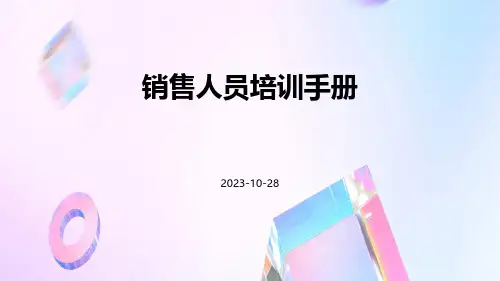
2023-10-28CATALOGUE目录•培训目标与价值•销售心理学基础•产品知识与销售技巧•客户分析与拓展方法•销售人员自我管理与发展•实战案例分享与经验总结01培训目标与价值了解客户购买行为背后的心理动机,从而更好地掌握销售技巧。
掌握销售心理学有效沟通销售谈判技巧学会如何与不同性格、背景的客户进行高效沟通,建立信任和共识。
掌握谈判策略和技巧,能够在销售过程中灵活应对客户反馈和需求变化。
03提升销售技能0201深入了解公司品牌和产品特点,能够准确解答客户疑问,提升客户满意度。
品牌与产品知识关注客户需求,提供优质服务,赢得客户信任和口碑传播。
服务质量与口碑培养良好的职业素养和礼仪习惯,提升个人形象和公司品牌形象。
职业素养与礼仪塑造专业形象学会倾听客户反馈和需求,从而更好地理解客户需求,提供个性化解决方案。
培养沟通能力倾听能力提高口头和书面表达能力,能够准确、清晰地传达产品特点和优势。
表达能力学会及时给予和接受反馈,能够在销售过程中不断改进和提升。
反馈与改进能力02销售心理学基础客户购买行为心理客户的购买动机购买动机是客户购买行为的基础,销售人员应学会分析客户的购买动机,以便更好地满足其需求。
客户的购买决策过程了解客户的购买决策过程,包括对信息的收集、评估和选择,有助于销售人员更好地引导客户。
客户的需求了解客户的需求是销售成功的关键,销售人员应学会发现、挖掘和满足客户的需求。
说服客户销售人员应学会运用有效的沟通技巧来说服客户,包括倾听、提问和引导等。
建立信任建立信任是销售成功的关键,销售人员应通过诚实、专业和可靠的表现来赢得客户的信任。
处理客户异议当客户对产品或服务提出异议时,销售人员应学会尊重并积极回应,以消除客户的疑虑。
销售过程中的心理策略1建立良好客户关系23提供优质的客户服务是建立良好客户关系的关键,销售人员应始终以客户为中心,积极解决客户的问题和关注客户的需求。
客户服务提高客户满意度有助于培养客户的忠诚度,销售人员应关注客户对产品的满意度并积极收集反馈。
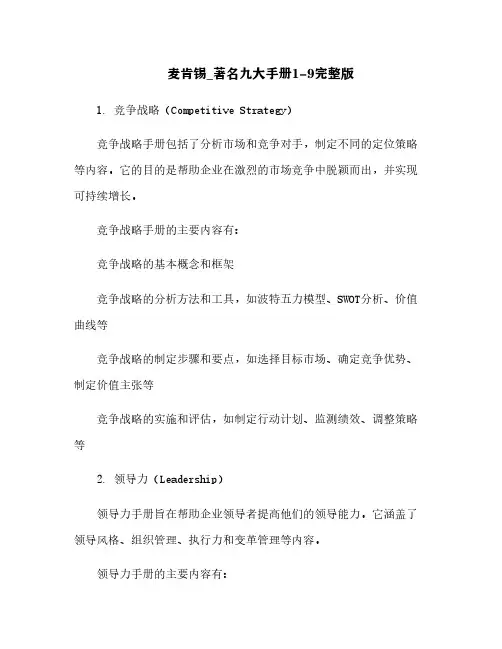
麦肯锡_著名九大手册1-9完整版1. 竞争战略(Competitive Strategy)竞争战略手册包括了分析市场和竞争对手,制定不同的定位策略等内容。
它的目的是帮助企业在激烈的市场竞争中脱颖而出,并实现可持续增长。
竞争战略手册的主要内容有:竞争战略的基本概念和框架竞争战略的分析方法和工具,如波特五力模型、SWOT分析、价值曲线等竞争战略的制定步骤和要点,如选择目标市场、确定竞争优势、制定价值主张等竞争战略的实施和评估,如制定行动计划、监测绩效、调整策略等2. 领导力(Leadership)领导力手册旨在帮助企业领导者提高他们的领导能力。
它涵盖了领导风格、组织管理、执行力和变革管理等内容。
领导力手册的主要内容有:领导力的定义和重要性领导力的类型和特征,如变革型领导、情境型领导、魅力型领导等领导力的评估和提升方法,如360度反馈、个人发展计划、教练辅导等领导力的应用场景和案例,如团队建设、冲突管理、危机处理等3. 价值链(Value Chn)价值链手册是一种工具,用于分析企业的价值链和业务模式。
它可以帮助企业发现更多的附加值和成本节约的机会。
价值链手册的主要内容有:价值链的概念和作用价值链的构成要素和分类,如主要活动、支持活动、上游活动、下游活动等价值链的分析方法和工具,如价值链地图、价值链分解、价值链优化等价值链的改进策略和案例,如降低成本、提高效率、增加差异化等4. 基础市场分析(Basic Market Analysis)基础市场分析手册指南行业对企业竞争的基本了解。
它介绍了如何分析市场规模、增长率、竞争格局、细分市场等基本知识。
基础市场分析手册的主要内容有:市场分析的目的和意义市场分析的数据来源和收集方法,如一手数据、二手数据、定量数据、定性数据等市场分析的技术和工具,如市场调研、市场预测、市场细分等市场分析的报告和呈现,如市场概况、市场趋势、市场机会等5. 买方行为分析(Buyer Behavior Analysis)买方行为分析手册涵盖了如何识别和理解客户所需的内容、购买习惯、购买决策的因素等知识,以帮助企业更好地满足顾客需求。

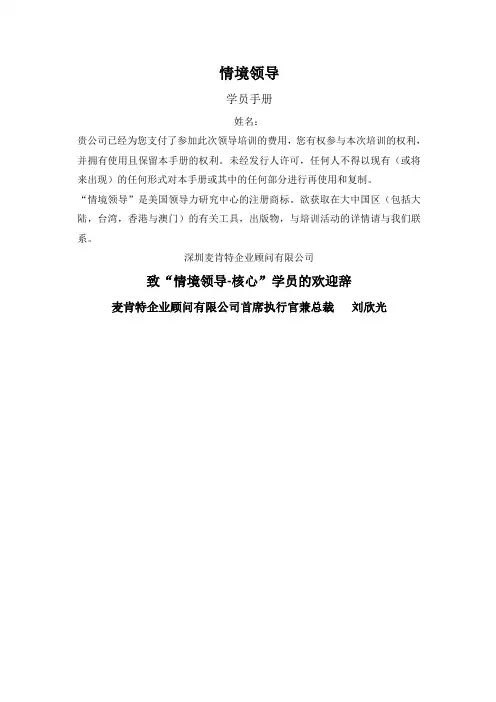
情境领导学员手册姓名:贵公司已经为您支付了参加此次领导培训的费用,您有权参与本次培训的权利,并拥有使用且保留本手册的权利。
未经发行人许可,任何人不得以现有(或将来出现)的任何形式对本手册或其中的任何部分进行再使用和复制。
“情境领导”是美国领导力研究中心的注册商标。
欲获取在大中国区(包括大陆,台湾,香港与澳门)的有关工具,出版物,与培训活动的详情请与我们联系。
深圳麦肯特企业顾问有限公司致“情境领导-核心”学员的欢迎辞麦肯特企业顾问有限公司首席执行官兼总裁刘欣光各位尊敬的贵宾:本人谨带边麦肯特公司对诸位致十二万分的谢意。
由于诸位的热诚参与,使得“情境领导”课程得以顺利展开。
在西方的管理理论中,以被领导者行为的表现作为领导者运用领导风格的基础是被广为接纳的一种理论。
因为今日的领导学说虽有各种学派,但大多数的领导学说都过度注重领导者本身的重要性,而忽略被领导者以及环境变迁所造成对领导效能的影响。
举例而言,今日在美国相当重要的理论为整体领导者()理论,意思是考查领导者在不同环境中应有不同的风格表现,但这个理论是以十分相信领导者是领导成功的最重要因素为基础的,至于对决定领导是否成功的被领导者因素却不太体积,可以说是相当遗憾的。
而先生所独创的情境领导则是将组织目标、领导者目标、被领导者目标结合,透过领导者对组织环境的变化与被领导者准备度的高低而给予合适的领导方式,可谓是极为均衡且易于执行的领导模式。
我曾多次提过,在我约三十年的饿职业生涯中,约有二十年的主管经验,而情境领导方式正是我的领导与管理的中心思想,以我在的经验而言,由于实行情境领导,被领导者的准备度是我极为重视的领导指标,根据绩效计划细分后的各种职责目的都是希望将被领导者发展到可以接受授权的境界,加上有极大的成长空间,当被领导者的意愿与能力被逐步发展,配合公司内部的水平与垂直调动的安排,至尽许多员工都被发展为公司的高阶主管甚至掌管各国的业务,我个人所带过的同仁中有数位目前即为太平洋总部的高级副总裁,这种看到自己曾经花过心血栽培的同仁日后成为公司的中流砥柱时,那种快乐的心情难以形容。
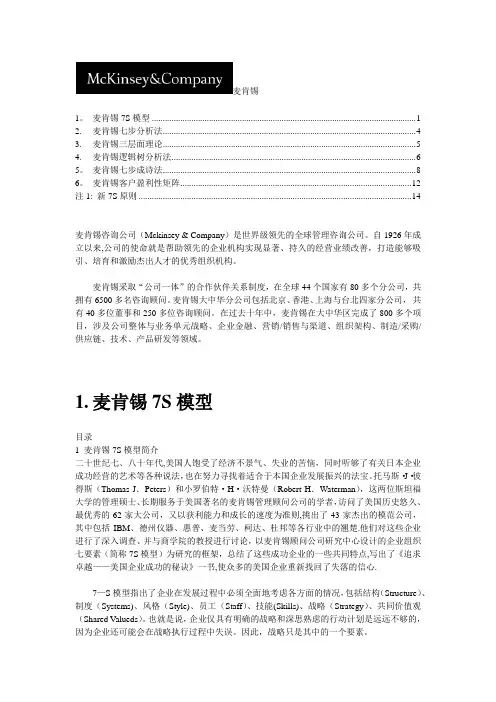
麦肯锡1。
麦肯锡7S模型 (1)2. 麦肯锡七步分析法 (4)3. 麦肯锡三层面理论 (5)4. 麦肯锡逻辑树分析法 (6)5。
麦肯锡七步成诗法 (8)6。
麦肯锡客户盈利性矩阵 (12)注1: 新7S原则 (14)麦肯锡咨询公司(Mckinsey & Company)是世界级领先的全球管理咨询公司。
自1926年成立以来,公司的使命就是帮助领先的企业机构实现显著、持久的经营业绩改善,打造能够吸引、培育和激励杰出人才的优秀组织机构。
麦肯锡采取“公司一体”的合作伙伴关系制度,在全球44个国家有80多个分公司,共拥有6500多名咨询顾问。
麦肯锡大中华分公司包括北京、香港、上海与台北四家分公司,共有40多位董事和250多位咨询顾问。
在过去十年中,麦肯锡在大中华区完成了800多个项目,涉及公司整体与业务单元战略、企业金融、营销/销售与渠道、组织架构、制造/采购/供应链、技术、产品研发等领域。
1.麦肯锡7S模型目录1 麦肯锡7S模型简介二十世纪七、八十年代,美国人饱受了经济不景气、失业的苦恼,同时听够了有关日本企业成功经营的艺术等各种说法,也在努力寻找着适合于本国企业发展振兴的法宝。
托马斯·J·彼得斯(Thomas J.Peters)和小罗伯特·H·沃特曼(Robert H.Waterman),这两位斯坦福大学的管理硕士、长期服务于美国著名的麦肯锡管理顾问公司的学者,访问了美国历史悠久、最优秀的62家大公司,又以获利能力和成长的速度为准则,挑出了43家杰出的模范公司,其中包括IBM、德州仪器、惠普、麦当劳、柯达、杜邦等各行业中的翘楚.他们对这些企业进行了深入调查、并与商学院的教授进行讨论,以麦肯锡顾问公司研究中心设计的企业组织七要素(简称7S模型)为研究的框架,总结了这些成功企业的一些共同特点,写出了《追求卓越——美国企业成功的秘诀》一书,使众多的美国企业重新找回了失落的信心.7—S模型指出了企业在发展过程中必须全面地考虑各方面的情况,包括结构(Structure)、制度(Systems)、风格(Style)、员工(Staff)、技能(Skills)、战略(Strategy)、共同价值观(Shared Valueds)。
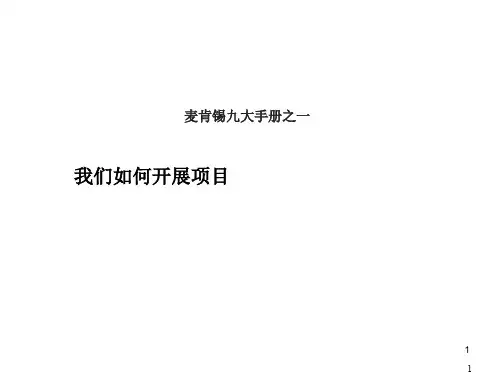
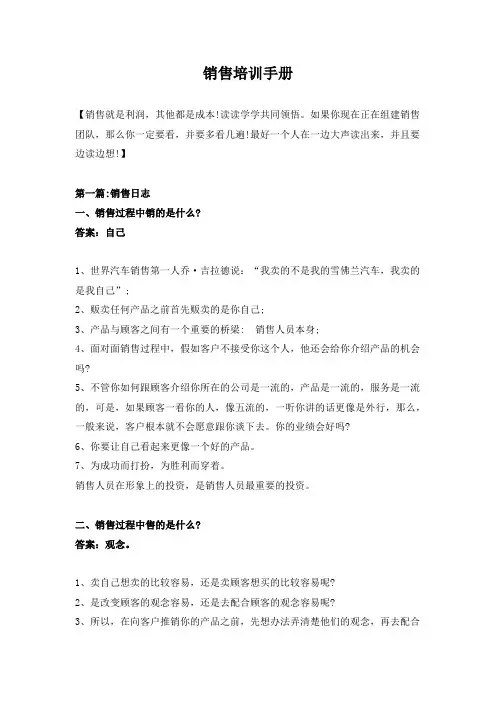
销售培训手册【销售就是利润,其他都是成本!读读学学共同领悟。
如果你现在正在组建销售团队,那么你一定要看,并要多看几遍!最好一个人在一边大声读出来,并且要边读边想!】第一篇:销售日志一、销售过程中销的是什么?答案:自己1、世界汽车销售第一人乔·吉拉德说:“我卖的不是我的雪佛兰汽车,我卖的是我自己”;2、贩卖任何产品之前首先贩卖的是你自己;3、产品与顾客之间有一个重要的桥梁: 销售人员本身;4、面对面销售过程中,假如客户不接受你这个人,他还会给你介绍产品的机会吗?5、不管你如何跟顾客介绍你所在的公司是一流的,产品是一流的,服务是一流的,可是,如果顾客一看你的人,像五流的,一听你讲的话更像是外行,那么,一般来说,客户根本就不会愿意跟你谈下去。
你的业绩会好吗?6、你要让自己看起来更像一个好的产品。
7、为成功而打扮,为胜利而穿着。
销售人员在形象上的投资,是销售人员最重要的投资。
二、销售过程中售的是什么?答案:观念。
1、卖自己想卖的比较容易,还是卖顾客想买的比较容易呢?2、是改变顾客的观念容易,还是去配合顾客的观念容易呢?3、所以,在向客户推销你的产品之前,先想办法弄清楚他们的观念,再去配合它。
4、如果顾客的购买观念跟我们销售的产品或服务的观念有冲突,那就先改变顾客的观念,然后再销售。
5、是客户掏钱买他想买的东西,而不是你掏钱; 我们的工作是协助客户买到他认为最适合的。
三、买卖过程中买的是什么?答案:感觉1、人们买不买某一件东西通常有一个决定性的力量在支配,那就是感觉。
2、感觉是一种看不见、摸不着的影响人们行为的关键因素。
3、它是一种人和人、人和环境互动的综合体。
4、假如你看到一套高档西装,价钱、款式、布料各方面都不错,你很满意。
可是销售员跟你交谈时不尊重你,让你感觉很不舒服,你会购买吗?假如同一套衣服在菜市场屠户旁边的地摊上,你会购买吗?不会,因为你的感觉不对。
5、企业、产品、人、环境、语言、语调、肢体动作都会影响顾客的感觉。
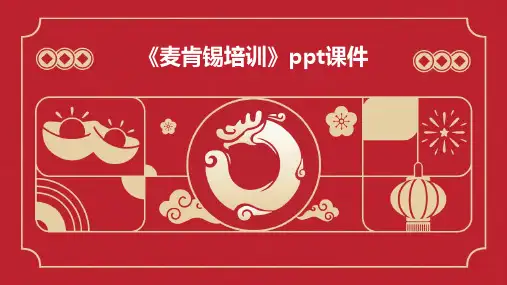
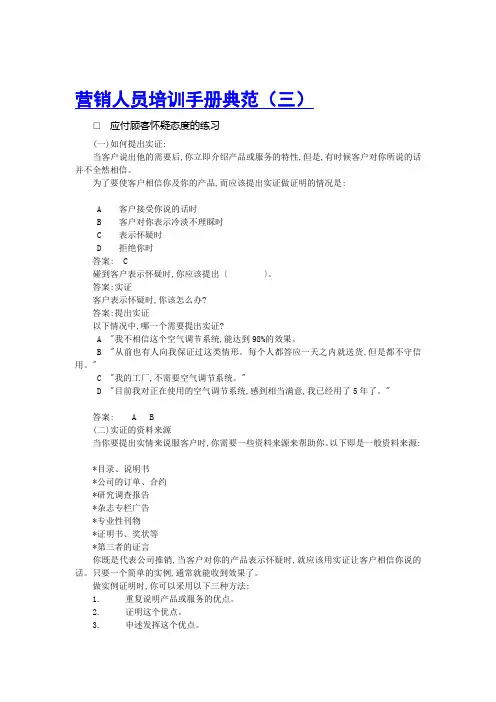
营销人员培训手册典范(三)□应付顾客怀疑态度的练习(一)如何提出实证:当客户说出他的需要后,你立即介绍产品或服务的特性,但是,有时候客户对你所说的话并不全然相信。
为了要使客户相信你及你的产品,而应该提出实证做证明的情况是:A 客户接受你说的话时B 客户对你表示冷淡不理睬时C 表示怀疑时D 拒绝你时答案: C碰到客户表示怀疑时,你应该提出〔〕。
答案:实证客户表示怀疑时,你该怎么办?答案:提出实证以下情况中,哪一个需要提出实证?A "我不相信这个空气调节系统,能达到98%的效果。
B "从前也有人向我保证过这类情形。
每个人都答应一天之内就送货,但是都不守信用。
"C "我的工厂,不需要空气调节系统。
"D "目前我对正在使用的空气调节系统,感到相当满意,我已经用了5年了。
"答案: A B(二)当你要提出实情来说服客户时,你需要一些资料来源来帮助你。
以下即是一般资料来源:*目录、说明书*公司的订单、合约*研究调查报告*杂志专栏广告*专业性刊物*证明书、奖状等*第三者的证言你既是代表公司推销,当客户对你的产品表示怀疑时,就应该用实证让客户相信你说的话。
只要一个简单的实例,通常就能收到效果了。
做实例证明时,你可以采用以下三种方法:1.重复说明产品或服务的优点。
2.证明这个优点。
3.申述发挥这个优点。
其实,第二个步骤,就是提出实例来证明产品或服务的优点,你该如何来做实证呢?〔〕。
答案:利用资料来证明。
请定出以下提出实证时的正确次序。
〔〕申述产品或服务的优点。
答案:3.〔〕证明此优点。
答案:2.〔〕重复说明此优点。
答案:1.当客户对你的产品或服务表示怀疑时,你应该:1.重复说明〔〕。
答案:产品的优点2.证明〔〕。
答案:此优点。
3.〔〕。
答案:申述发挥此优点。
当客户表示怀疑时,你该采取哪三个步骤?1.〔〕。
答案:重复说明产品或服务的优点。
2.〔〕。
•了解被访者认为的工作重点•表明被访谈者的观点/判断标准•给被访谈者更多的成就感•给被访谈者组织答案的自由•提供更广泛、更深入的答案•可能引出意料之外(而宝贵)的信息•鼓励被访者畅所欲言•有助于了解被访谈者对议题深度的认知•耗费时间和精力•难以控制访谈节奏•难以记录或整理答案•更难核查结果•被访谈者很难把握回答的深度•节省时间和精力•最大程度地控制访谈节奏•在你知道自己想要什么具体信息时的最佳提问方式•更容易整理和归类•帮助缺乏经验的访谈者•有助于重新组织访谈结构•鼓励内向/不爱直接了当说话的被访谈者阐明自己的观点•用更少的时间完成更多的工作•在不需要解释时的最佳提问方式•所获得的信息有限•被访谈者无法对自己的回答做进一步解释或说明•较难辨别出虚假信息澄清概念保证理解正确探询加深理解质疑获得证据/证明,鼓励提出新观点假设尤其是不受欢迎的观点主题上假设您的竞争对手对各种方案优先排序/在不同选项之间取舍A 事实收集信息拓宽思路鼓励创造性思维质量与数量之间建立良好关系,增进信任发生那些变化时引导沉默的人发言领域;您对老李的建议会怎么回答?重新让讨论重点回到正轨上这一点与主要议题是什么关系?总结议题,核实结论的正确性这些是您所认为的主要障碍吗?避免落入典型的访谈陷阱双重问题“您为什么使用甲产品,对该生产商有何了解?”关联性问题“您怎样才能使客户感到满意,从而买得更多?”导向性问题“您喜欢这个品牌吧?”尖锐问题“难道您不认为您应该停止. . .?”重申访谈目标决定由谁进行访谈确定成员的角色谁做开场白,谁收场?谁要负责记录?如何给小组成员分配不同的访谈题目组建访谈小组让整个小组成员都明确访谈目的计划如何掌握时间,包括各议题的时间分配–是深度重要还是广度重要–是否有时间限制区别“必须了解的信息”和“最好了解的儿信息”确定访谈要达到的最终目标整理思路自我介绍感谢被访者能抽空接见你,通报访谈的目的及时限营造良好氛围及增加好感–自我介绍–事先告诉被访者,我们将在采访时做记录,并说明记录的用途–如需要,向被访人重申我们将严格为访谈内容保密–态度友好营造良好的访谈氛围鼓励被访谈者先花时间消除不确定因素打消被访者的顾虑:这将保证被访谈者能顺利回答所有问题畅所欲言:在进入正题之前,有时被访谈者要先发泄一下抑制已久的情绪表示投合默契:大多数人都喜欢诚恳热诚的态度认可/表扬:予以肯定能鼓励双方交谈质疑并刺激–只有在建立了较好关系时才适用外部奖励或威胁–只作为最后采取的方法悉心探究尽可能少说,鼓励对方提供更多信息通过点头或中性词表达自己的态度(“对”、“嗯”、“好”、“我知道了”)明确:要求陈述真实案例或具体事实逐字重复,检验理解是否正确阶段性总结理解被访者合理的顾虑保证对一个问题充分讨论完之后再转向下一个问题有效地聆听聆听并记住–用关键词总结听到的信息–广泛地联想细心聆听,从长篇大论中搜集到有价值的信息注意被访谈者的潜台词找出没有用语言表达出的线索不断地总结、归纳并及时地与被访谈者核实总结要点提问最后一个开放式问题“有没有什么没有谈到的问题您想补充的?”就下一步工作达成共识为今后进一步提问留有余地谢谢被访谈者,表示说讨论很有意义在48个小时之内送出致谢信结束访谈确定访谈目标确认访谈是否是获取信息的最佳途径–访谈耗时较长建立访谈背景资料考虑细节问题–时间、地点,如可能,亲自安排访谈尽可能了解与访谈有关的基本情况(例如:竞争对手、行业术语等)如果你要索取某些文件,应事先通知被访谈者以“问题树”为基础设计访谈提纲在整个过程中,不断修改访谈提纲和议题在对被访谈者没有风险的环境中进行访谈注意力集中,表示出对访谈者的尊敬,访谈时不要迟到使被访谈者有交谈的意愿,不要咄咄逼人处处为被访谈者考虑保持适当的眼神接触灵活应对,不应完全局限于访谈提纲,在适当时候也可以完全抛弃访谈提纲完成后续工作;履行诺言不要一口气做太多的访谈,试着在两次访谈中间做些分析工作及时记录谈话要点(例如,通过给自己电话留言)遵循80/20原则–在20小时内写完访谈纪要–与其在一个星期内完成一个完美的访谈纪要,不如立即做一个有80%准确性的访谈纪要在访谈纪要中应提及被访谈者对问题的反应和态度,而不仅仅局限于她的回答引用被访谈者原话,以此强调重要观点对被访谈对象的观点/评论,持必要的怀疑态度成分排序频率分布时间序列关联性。
The power of pricingTransaction pricing is the key to surviving the current downturn—and to flourishing when conditions improve. February 2003 • Michael V. Marn, Eric V. Roegner, and Craig C. ZawadaAt few moments since the end of World War II has downward pressure on prices been so great. Some of it stems from cyclical factors—such as sluggish economic growth in the Western economies and Japan—that have reined in consumer spending. There are newer sources as well: the vastly increased purchasing power of retailers, such as Wal-Mart, which can therefore pressure suppliers; the Internet, which adds to the transparency of markets by making it easier to compare prices; and the role of China and other burgeoning industrial powers whose low labor costs have driven down prices for manufactured goods. The one-two punch of cyclical and newer factors has eroded corporate pricing power and forced frustrated managers to look in every direction for ways to hold the line.In such an environment, managers might think it mad to talk about raising prices. Yet nothing could be further from the truth. We are not talking about raising prices across the board; quite often, the most effective path is to get prices right for one customer, one transaction at a time, and to capture more of the price that you already, in theory, charge. In this sense, there is room for price increases or at least price stability even in today's difficult markets.Such an approach to pricing—transaction pricing, one of the three levels of price management (see sidebar "Pricing at three levels")—was first described ten years ago.1 The idea was to figure out the real price you charged customers after accounting for a host of discounts, allowances, rebates, and other deductions. Only then could you determine how much money, if any, you were making and whether you were charging the right price for each customer and transaction.A simple but powerful tool—the pocket price waterfall, which shows how much revenue companies really keep from each of their transactions—helps them diagnose and capture opportunities in transaction pricing. In this article, we revisit that toolto see how it has held up through dramatic changes in the way businesses work and in the broader economy. Our experience serving hundreds of companies on pricing issues shows that the pocket price waterfall still effectively helps identify transaction-pricing opportunities. Nevertheless, in view of evolving business practice, we have greatly expanded the tool's application. The increase in the number of companies selling customized products and solutions or bundling service packages with each sale, for instance, means that assessing the profitability of transactions has become much more complex. The pocket price waterfall has evolved over time to take account of this transition.Today, it is more critical than ever for managers to focus on transaction pricing; they can no longer rely on the double-digit annual sales growth and rich margins of the 1990s to overshadow pricing shortfalls. Moreover, at many companies, littlecost-cutting juice can easily be extracted from operations. Pricing is therefore one of the few untapped levers to boost earnings, and companies that start now will be in a good position to profit fully from the next upturn.Advancing one percentage point at a timePricing right is the fastest and most effective way for managers to increase profits. Consider the average income statement of an S&P 1500 company: a price rise of 1 percent, if volumes remained stable, would generate an 8 percent increase in operating profits (Exhibit 1)—an impact nearly 50 percent greater than that of a 1 percent fall in variable costs such as materials and direct labor and more than three times greater than the impact of a 1 percent increase in volume.Unfortunately, the sword of pricing cuts both ways. A decrease of 1 percent in average prices has the opposite effect, bringing down operating profits by that same 8 percent if other factors remain steady. Managers may hope that higher volumes will compensate for revenues lost from lower prices and thereby raise profits, but this rarely happens; to continue our examination of typical S&P 1500 economics, volumes would have to rise by 18.7 percent just to offset the profit impact of a 5 percent price cut. Such demand sensitivity to price cuts is extremely rare. A strategy based on cutting prices to increase volumes and, as a result, to raise profits is generally doomed to failure in almost every market and industry.Following the pocket price waterfallMany companies can find an additional 1 percent or more in prices by carefully looking at what part of the list price of a product or service is actually pocketed from each transaction. Right pricing is a more subtle game than setting list prices or even tracking invoice prices. Significant amounts of money can leak away from list or base prices as customers receive discounts, incentives, promotions, and other giveaways to seal contracts and maintain volumes (see sidebar "A hole in your pocket").The experience of a global lighting supplier shows how the pocket price—what remains after all discounts and other incentives have been tallied—is usually much lower than the list or invoice price. This company made incandescent lightbulbs and fluorescent lights sold to distributors that then resold them for use in offices, factories, stores, and other commercial buildings. Every lightbulb had a standard list price, but a series of discounts that were itemized on each invoice pushed average invoice prices 32.8 percent lower than the standard list prices. These on-invoice deductions included the standard discounts given to most distributors as well as special discounts for selected ones, discounts for large-volume customers, and discounts offered during promotions.Managers who oversee pricing often focus on invoice prices, which are readily available, but the real pricing story goes much further. Revenue leaks beyond invoice prices aren't detailed on invoices. The many off-invoice leakages at the lighting company included cash discounts for prompt payment, the cost of carrying accounts receivable, cooperative advertising allowances, rebates based on a distributor's total annual volume, off-invoice promotional programs, and freight expenses. In the end, the company's average pocket price—including 16.3 percentage points in revenue reductions that didn't appear on invoices—was about half of the standard list price (Exhibit 2a). Over the past decade, companies have tried to entice buyerswith a growing number of discounts, including discounts for on-line orders as well as the increasingly popular performance penalties that require companies to provide a discount if they fail to meet specific performance commitments such as on-time delivery and order fill rates.By consciously and assiduously managing all elements of the pocket price waterfall, companies can often find and capture an additional 1 percent or more in their realized prices. Indeed, an adjustment of any discount or element along the waterfall—either on- or off-invoice—is capable of improving prices on a transaction-by-transaction basis.Embracing a wide bandThe pocket price waterfall is often first created as an average of all transactions. But the amount and type of the discounts offered may differ from customer to customer and even order to order, so pocket prices can vary a good deal. We call the distribution of sales volumes over this range of variation the pocket price band.At the lighting company, some bulbs were sold at a pocket price of less than 30 percent of the standard list price, others at 90 percent or more—three times higher than those of the lowest-priced transactions (Exhibit 2b). This range may seem spectacular, but it is not very unusual. In our work, we have seen pocket price bands in which the highest pocket price was five or six times greater than the lowest.A wide band shows that certain customers generate much higher pocket prices than do othersIt would be a mistake, though, to assume that wide pocket price bands are necessarily bad. A wide band shows that neither all customers nor all competitive situations are the same—that for a whole host of reasons, some customers generate much higher pocket prices than do others. When a band is wide, small changes in its shape can readily move the average price a percentage point or more higher. If a manager can increase sales slightly at the high end of the band while improving or even dropping transactions at the low end, such an increase comes within reach. But when the price band is narrow, the manager has less room to maneuver; changing its shape becomes more difficult; and any move has less impact on average prices.Although the lighting company was surprised by the width of its pocket price band, it had a quick explanation: the range resulted from a conscious effort to reward high-volume customers with deeper discounts, which in theory were justified notonly by the desire to court such customers but also by a lower cost to serve them. A closer examination showed that this explanation was actually wide of the mark (Exhibit 3): many large customers received relatively modest discounts, resulting in high pocket prices, while a lot of small buyers got much greater discounts and lower pocket prices than their size would warrant. A few smaller customers received large discounts in special circumstances—unusually competitive or depressed markets, for instance—but most just had long-standing ties to the company and knew which employees to call for extra discounts, additional time to pay, or more promotional money. These experienced customers were working the pocket price waterfall to their advantage.The lighting company attacked the problem from three directions. First, it instructed its sales force to bring into line—or drop—the smaller distributors getting unacceptably high discounts. Within 12 months, 85 percent of these accounts were being priced and serviced in a more appropriate way, and new accounts had replaced most of the remainder. Second, the company launched an intensive program to stimulate sales at larger accounts for which higher pocket prices had been realized. Finally, it controlled transaction prices by initiating stricter rules on discounting and by installing IT systems that could track pocket prices more effectively. In the first year thereafter, the average pocket price rose by 3.6 percent and operating profits by 51 percent.In addition to these immediate fixes, the lighting company took longer-term measures to change the relationship between pocket prices and the characteristics of its accounts. New and explicit pocket price targets were based on the size, type, and segment of each account, and whenever a customer's prices were renegotiated or a new customer was signed, that target guided the negotiations.Pocket margins become more relevantFor companies that not only sell standard products and services but also experience little variation in the cost of selling and delivering them to different customers, pocket prices are an adequate measure of price performance. Today, however, as companies seek to differentiate themselves amid growing competition, many are offering customized products, bundling product and service packages with each sale, offering unique solutions packages, or providing unique forms of logistical andtechnical support. Pocket prices don't capture these different product costs or the cost to serve specific customers. For such companies, another level of analysis—the pocket margin—is needed to reflect the varying costs associated with each order. The pocket margin for a transaction is calculated by subtracting from the pocket price any direct product costs and costs incurred specifically to serve an individual account.One North American company, which manufactures tempered glass for heavy trucks and for farm and construction machinery, sharply increased its profits by understanding and actively managing its pocket margins. Each piece of the company's glass was custom-designed for a specific customer, so costs varied transaction by transaction. Other costs differed from customer to customer as well. The company's glass, for example, was frequently shipped in special containers that were designed to be compatible with the customers' assembly machines. The costs of retooling and other customer-specific services varied widely from case to case but averaged no less than 17 percent of the target base price (Exhibit 4a).A fuller picture emerges when a company examines each account and creates a pocket margin bandAs with pocket prices, a fuller picture emerges when a company examines each account and creates a pocket margin band. The glass company's pocket margins ranged from more than 60 percent of base prices to a loss of more than 15 percent of base prices (Exhibit 4b). When fixed costs were allocated, the company found that it required a pocket margin of at least 12 percent just to break even at the current operating level. More than a quarter of the company's sales fell below this threshold.Traditionally, the pricing policies of the glass company had focused on invoice prices and standard product costs; it paid little attention to off-invoice discounts or extra costs to serve specific customers. The pocket margin band helped it identify which individual customers were more profitable and which should be approached more aggressively even at the risk of losing their business. The company also uncovered narrowly defined customer segments (for example, medium-volume buyers of flat or single-bend door glass) that were concentrated at the high end of the margin band. In addition, it evaluated its policies for some of the more standard waterfall elements to ensure that it had clear objectives, accountability, and controls for each of them—for instance, it decided to base volume bonuses on stretch performance targets and to charge for last-minute technical support. By focusing on and increasing sales in profitable subsegments, pruning less attractive accounts, and making selective policy changes across the waterfall elements, the company pushed up its average pocket margin by 4 percent and its operating profits by 60 percent within a year.Taming transactionsThe game of transaction pricing is won or lost in hundreds, sometimes thousands, of individual decisions each day. Standard and discretionary discounts allow percentage points of revenue to drop from the table one transaction at a time. Companies are often poorly equipped to track these losses, especially for off-invoice items; after all, the volumes and complexity of transactions can be overwhelming, and many items, such as cooperative advertising or freight allowances, are accounted for after the fact or on a company-wide basis. Even if managers wanted to track transaction pricing, it has often been impossible to get the data for specific customers or transactions. But some recent technical advances have helped remove this obstacle; enterprise-management-information systems and off-the-shelf custom-pricing software have made it easier to keep tabs on transaction pricing. Managers can no longer hide behind the excuse that gathering the data is too difficult.Current price pressures should go a long way toward removing two other obstacles: will and skill. In the booming economy of the 1990s, robust demand and cost-cutting programs, which drove up corporate earnings, made too many managers pay too little attention to pricing. But now that a global economic downturn has slowed growth and the easiest cost cutting has already occurred, the shortfall in pricing capabilities has been exposed. A large number of companies still don't understand the untapped opportunity that superior transaction pricing represents. For many companies, getting it right may be one of the keys to surviving the current downturn and to flourishing when the upturn arrives. It has never been more crucial—ormore possible—to learn and apply the skills needed to execute superior transaction-price management.Pricing at three levelsTransaction pricing is one of three levels of price management. Although distinct, each level is related to the others, and action at any one level could easily affect the others as well. Businesses trying to obtain a price advantage—that is, to make superior pricing a source of distinctive performance—must master all three of these levels.Industry price level. The broadest view of pricing comes at the industry price level, where managers must understand how supply, demand, costs, regulations, and other high-level factors interact and affect overall prices. Companies that excel at this level avoid unnecessary downward pressure on prices and often emerge as industry price leaders.Product/market strategy level. The primary issue at this second level is pricing a product or service relative to the competition. To do so, companies must understand how customers perceive all offerings on the market and, most particularly, which attributes—product as well as service and intangible attributes—drive purchase decisions. With this knowledge, companies can set visible list prices that accurately reflect the competitive strengths (or weaknesses) of their offerings.Transaction level. The focus of transaction pricing is to decide the exact price for each transaction—starting with the list price and determining which discounts, allowances, payment terms, bonuses, and other incentives should be applied. For a majority of companies, the management of transaction pricing is the most detailed, time-consuming, systems-intensive, andenergy-intensive task involved in gaining a price advantage.A hole in your pocketMany on- and off-invoice items can easily lead to price and margin leaks. Here we provide a nonexhaustive list:Annual volume bonus: an end-of-year bonus paid to customers if preset purchase volume targets are met.Cash discount: a deduction from the invoice price if payment for an order is made quickly, often within 15 days. Consignment cost: the cost of funds when a supplier provides consigned inventory to a wholesaler or retailer.Cooperative advertising: an allowance paid to support local advertising of the manufacturer’s brand by a retailer or wholesaler.End-customer discount: a rebate paid to a retailer for selling a product to a specific customer—often a large or national one—at a discount.Freight: the cost to the company of transporting goods to the customer.Market-development funds: a discount to promote sales growth in specific segments of a market.Off-invoice promotions: a marketing incentive that would, for example, pay retailers a rebate on sales during a specific promotional period.On-line order discount: a discount offered to customers ordering over the Internet or an intranet.Performance penalties: a discount that sellers agree to give buyers if performance targets, such as quality levels or delivery times, are missed.Receivables carrying cost: the cost of funds from the moment an invoice is sent until payment is received.Slotting allowance: an allowance paid to retailers to secure a set amount of shelf space.Stocking allowance: a discount paid to wholesalers or retailers to make large purchases into inventory, often before a seasonal increase in demand.The challenges ahead for supply chains: McKinsey Global Survey resultsSenior executives say their companies manage key trade-offs well, yet see barriers to better performance: rising risk, lack of collaboration, and low CEO involvement.As economies around the world step back from the financial brink and begin adjusting to a new normal, companies face a different set of supply chain challenges than they did at the height of the downturn—among them are rising pressure from global competition, consumer expectations, and increasingly complex patterns of customer demand. Executives in this McKinsey survey1are divided on their companies’ preparedness to meet those challenges, and fully two-thirds expect supply chain risk to increase. What’s more, the survey highlights troubling signs of struggle associated with key, underlying supply chain processes and capabilities, including the ability of different functions to collaborate, the role of CEOs in supply chain planning, and the extent to which companies gather and use information.Emerging from the downturnAs companies have managed their supply chains over the past three years, the challenges they faced and the goals they set have reflected a single-minded focus on weathering the financial crisis. The most frequently cited challenge of the past three years is the increasing volatility of customer demand (Exhibit 1). This is no doubt a result of the sharp drop in consumer spending that has reverberated throughout all sectors across the globe. Looking at challenges over the next five years, though, the focus shifts: respondents most frequently cite increasing pressure from global competition. Some issues that receive a lot of public attention, such as climate change and natural-resource use, have remained a low priority since our 2008 survey.2 Still, the share that identify environmental concerns as a top challenge in the next five years nearly doubled, to 21 percent, over the proportion saying it was a top challenge during the past three years. This suggests that companies anticipate returning to a new normal,3 wherein they can focus on issues other than cost at least some of the time.With regard to goals for supply chain management, the results show a similar shift between past and future, perhaps another indicator that companies are focusing on pursuing growth in addition to cost containment (Exhibit 2). Of course, executives are not ignoring supply chain costs altogether; after weathering a downturn, they know their companies can manage and control future expenses, now that this issue has been on their radar consistently. Indeed, reducing operating costs remains the most frequently chosen goal over the next five years—as it was over the past three—followed by customer service. In a 2008 survey, 43 percent of respondents said improving service was one of their companies’ top two goals for supply chain management, and though it fell as a priority during the crisis, it is now number two for the next five years.Executives also indicate that many of their companies have met past goals, with supply chain performance improving in both efficiency and effectiveness as they come out of the downturn. For example, nearly half say th eir companies’ service levels are higher now than they were three years ago, 39 percent say costs as a percentage of sales are lower, and 45 percent have cut inventories.What hasn’t changed much, though, is the amount of supply chain risk that executives foresee (Exhibit 3). More thantwo-thirds say risk increased in the past three years, and nearly the same share see risk continuing to rise. Respondents in developed Asian countries report more concern than those in any other region: 82 percent say their c ompanies’ supply chain risk will increase in the next five years.4Managing challenges and trade-offsThough the strategic goals executives are setting suggest a hope that more predictable business conditions will prevail over the next five years, respondents are divided over how well their companies can manage the challenges (Exhibit 4). This finding holds true for large and small companies alike and among executives in different functions.The good news is that on the three challenges cited most frequently (global competition, rising consumer expectations, and complex patterns of customer demand), the highest shares of executives say their companies are prepared to meet those challenges. The bad news is that the shares saying their companies are well prepared are still below half.Most executives recognize the importance of managing the functional trade-offs related to these challenges and think that their companies are effective at doing so. Among trade-offs, the highest share of respondents—85 percent—say balancing cost to serve and customer service is important to their companies’ supply chain strategy. The lowest share (59 percent) say balancing centralized production against proximity to customers is important. Respondents also report that the managers who make decisions about supply chain trade-offs are well informed.Yet the cross-functional discussions that companies need if they are to make informed decisions are not happening often. For each of the six trade-offs the survey explored, regular cross-functional meetings are cited as the most common process for making decisions, but between 31 and 40 percent of respondents say their operations teams never or rarely meet with salesand marketing to discuss supply chain tensions. Furthermore, respondents across functions say sales/marketing has the most difficulty collaborating with other functions, with 23 percent citing a problem between that group and manufacturing, and 21 percent between it and planning. Additionally, one-third of respondents say the biggest barrier to collaborating when managing trade-offs is that functional areas don’t understand their impact on others.This disconnection is likely exacerbated by the relatively low levels of CEO involvement reported: the vast majority of CEOs do not actively develop supply chain strategy or work hands-on to execute it (Exhibit 5). Respondents do, however, expect more CEO involvement over the next five years—a hopeful sign for companies aspiring to mend key cross-functional disconnections.Knowledge is powerThe results show a similar disconnection between data and decision making: companies seem to collect and use much less detailed information than our experience suggests is prudent in making astute supply chain decisions (Exhibit 6). For example, customer service is becoming a higher priority, and executives say their companies balance service and cost to serve effectively, yet companies are most likely to take a one-size-fits-all approach when defining and managing service-level targets. Half of the executives say their companies have limited or no quantitative information about incremental costs for raw materials, manufacturing capacity, and personnel, and 41 percent do not track per-customer supply chain costs at any useful level of detail.Many of the future supply chain challenges will require companies to keep better information on individual costs and customers. Yet only about a quarter of respondents expect their companies will invest in IT systems over the next five years, and only 10 percent of respondents say their companies currently use social media to identify customers’ service needs.Looking ahead∙In our experience, senior-executive involvement, including hands-on attention from the CEO, is pivotal in managing the cross-functional trade-offs that underpin many supply chain decisions. Yet the role of CEOs at many companies we surveyed is limited or nonexistent. Companies that can bridge the functional divides that thwart collaboration will have an edge in creating competitive supply chains capable of fulfilling business strategy requirements.∙Addressing the challenges companies have identified—improving service and responding to new expectations and patterns of customer demand—requires more and better information, regardless of the geographical scope or the length of supply chains.As the marketplace becomes increasingly fragmented, keeping better track of customer information and costs, which can inform and support interpersonal, cross-functional discussions, will help companies prepare for the supply chainuncertainties that lie ahead.∙Despite the importance of volatile commodity prices as a supply chain challenge, just 28 percent of respondents say their companies are prepared to manage that volatility. One way to cope with this uncertainty: view supply chain assets as a hedge.By considering investment in production resources that aren’t necessarily lowest-cost today (but soon could be), companies can position themselves for greater flexibility in the future.∙Executives expect environmental concerns to be a more significant issue for supply chains in the years ahead, yet relatively few consider it a priority today. Given that up to 60 percent of a company’s carbon footprint can reside upstr eam in its supply chain,5 companies would be wise to pursue economically attractive opportunities that address environmental impact in the near term and prepare to respond quickly to any sudden shifts in environmental expectations and requirements.A new idea in banking for the poorBy teaming up with retail outlets in low-income, often hard-to-reach areas, financial institutions can create value both for themselves and their new customers.November 2010 • Alberto Chaia, Robert Schiff, and Esteban Silva。
本文部分内容来自网络整理,本司不为其真实性负责,如有异议或侵权请及时联系,本司将立即删除!== 本文为word格式,下载后可方便编辑和修改! ==麦肯锡,建议书篇一:麦肯锡案例分析全集内容目录:麦肯锡《人才测评业务方法论介绍》66页.ppt麦肯锡《上海环保集团---创建杰出的董事会》.ppt麦肯锡《中国电信—产品与服务市场细分研究报告》71页.ppt麦肯锡《中国电信---市场细分是为客户创造价值过程中的关键》109页.ppt 麦肯锡《中国企业如何改善绩效管理》67页.ppt麦肯锡《中国石化公司---营销培训卓越的定价策略》204页.ppt 麦肯锡KPI 资料.ppt麦肯锡TCL股份组织结构设计方案.ppt麦肯锡爱情报告.pdf麦肯锡—百威啤酒战略报告.ppt麦肯锡的工商银行深圳分行业绩改善与客户管理.ppt麦肯锡的市场研究方法.ppt麦肯锡的营销工具箱 .pdf麦肯锡方法(电子书).exe麦肯锡给大唐电信作的战略.ppt麦肯锡给医药行业的报告.ppt麦肯锡公司管理咨询的标准流程—麦肯锡招商局项目.ppt麦肯锡-黑龙江庆新油田业绩管理报告.ppt麦肯锡价格战略.ppt麦肯锡建立高绩效的市场营销及销售组织体系.PPT 麦肯锡-降低成本的一些分析方法.ppt麦肯锡解决问题的基本方法–“七步法”.ppt麦肯锡-金新信托-建立完善的产业投资流程.ppt 麦肯锡经典著作-用图表说话.pdf麦肯锡-均瑶集团战略咨询项目建议书.ppt麦肯锡-康佳广告促销计划流程实施手册.ppt麦肯锡客户服务培训手册.ppt麦肯锡—麦肯锡顾问客户服务培训手册.RAR麦肯锡-某数码公司战略.ppt麦肯锡培训2.ppt麦肯锡—平安人力资源方案集成.RAR麦肯锡-日本东芝中国公司战略.ppt麦肯锡三星战略1(motorola).ppt麦肯锡三星战略2(nokia).ppt麦肯锡三星战略3(西门子).ppt麦肯锡三星战略4(爱立信).ppt麦肯锡—上柴的战略咨询.ppt麦肯锡上海联通固定市场举措.ppt麦肯锡—上海汽车城.ppt麦肯锡实达案例分析.ppt麦肯锡为某电力做的经营计划与预算管理流程最佳做法及诊断.ppt麦肯锡-迅速改善XX银行零售业务销售业绩.ppt麦肯锡—伊拉克战后重建机会研究报告.ppt麦肯锡意识.ppt麦肯锡营销咨询手册.ppt麦肯锡—战略规划模板 .ppt麦肯锡战略讲稿.ppt麦肯锡—中国联通:开拓业务增长的战略.PPT麦肯锡-中国网通FY02宽带业务组织结构咨询分析报告.ppt 麦肯锡-中粮集团业绩管理咨询报告.ppt麦肯锡-中信银行.ppt麦肯锡自我全面介绍.ppt平安咨询-员工发展(麦肯锡).ppt麦肯锡《上海环保集团---人力资源规划详解》78页.ppt麦肯锡《康佳集团股份有限公司---信息管理流程实施方案》130页.ppt 麦肯锡-03年一个航空物流园区的项目建议书.ppt麦肯锡康佳广告促销流程.ppt麦肯锡联想集团战略规划.PPT麦肯锡中粮集团战略咨询报告.ppt麦肯锡百威咨询项目报告.ppt麦肯锡奇瑞TII整合营销策略.ppt麦肯锡中国联通组织结构设计.ppt麦肯锡《IT服务业务国际及国内趋势分析》33页.ppt麦肯锡《宝钢股份公司---系统的解决问题的方法》68页.ppt 麦肯锡《工作手册---访谈技巧概述与基本框架》27页.ppt 麦肯锡《降低成本的一些分析方法》25页.ppt篇二:麦肯锡管理咨询策划报告全集 (500套)总目录:01-麦肯锡_图表模板 ppt格式02-麦肯锡05年2月最新报告全球资本市场研究.pdf03-麦肯锡—第一年咨询顾问培训教材(全套)04-麦肯锡高层管理论丛(季刊) - 金融服务行业05-麦肯锡—广电股份全套咨询方案(14个文件)06-麦肯锡经典营销分析全套07-麦肯锡九大手册08-麦肯锡康佳咨询09-麦肯锡培训合集10-麦肯锡—平安人力资源方案集成11-麦肯锡全套管理资料PDF12-麦肯锡—神州数码KPI13-麦肯锡-实达项目报告(全套)14-麦肯锡意识、麦肯锡方法15-麦肯锡—政府教育咨询报告16-麦肯锡——咨询顾问培训手册(四合一)17-麦肯锡资料打包18-平安咨询-员工发展(麦肯锡)19-56个pdf文件20-54个ppt文件21-6个doc文件详细目录:【201X年中国彩铃市场研究简版报告】.pdf【xx国内知名红酒加盟手册】.ppt【海尔-电通企划全案】.ppt031麦肯锡-为广东电信总经理级别进行的BPR培训材料(商业客户营销理念).pptAppendix1_岗位描述手册.pptBOOK.chmMckinsey&GE矩阵法.pdfPDCA循环_PDCA Cycle_.pdfSWOT分析模型_SWOT Analysis_.pdfThumbs.db比照世界一流业绩.pdf标杆分析法_benchmarking_.pdf策略盲點1.htm策略盲點2.htm策略盲點3.htm打败麦肯锡.doc大中华科技高速公路.[].pdf改造IT服务.[].pdf高科技业的「适者生存」.[].pdf供应链的另一端.pdf麦肯锡把握中国资本市场的机遇.ppt麦肯锡宝钢股份精益生产诊断结果.ppt麦肯锡平安保险薪酬改革咨询报告.ppt麦肯锡中国电信产品与服务市场细.ppt麦肯锡中国电信大客户培训战略报.ppt麦肯锡中信实业银行私人银行经理.PPT麦肯锡_中粮集团战略咨询报告.ppt麦肯锡《创意打造奇瑞TII制胜的整合营销策略,造就SUV市场的营销奇迹》.ppt麦肯锡《通过严谨的市场研究,创意打造奇瑞TII制胜的整合营销策略,造就SUV市场的营销奇迹》34页 .ppt麦肯锡《中国电信---BPR业务技能培训》第二部分.ppt麦肯锡《中国电信---BPR业务技能培训》第三部分.ppt麦肯锡《中国电信---BPR业务技能培训》第一部分.ppt麦肯锡《重庆金夫人婚纱连锁集团公司---打造制胜的发展战略,推动金夫人快速增长,基业长青:最终报告》106页.pdf麦肯锡03年7月—中国均瑶集团战略咨询项目建议书.ppt麦肯锡7S模型_Mckinsey 7S Model_.pdf麦肯锡-IT服务业务国际与国内趋势分析.PPT麦肯锡IT服务业务趋势分析.pdf麦肯锡—NOKIA制胜美国市场报告.ppt麦肯锡—TCL股份公司管理整合咨询方案.ppt麦肯锡—TCL组织设计方案报告.ppt麦肯锡-奥迪中国渠道管理建议书 -.ppt麦肯锡—把握中国资本市场的机遇.ppt麦肯锡—宝钢股份精益生产诊断结果汇报报告.ppt麦肯锡标准流程——招商局项目.ppt麦肯锡-大唐电信确立制胜战略,决定产权结构和组织结构.PPT麦肯锡—大唐电信战略的制定方法咨询报告.ppt麦肯锡—德隆公司进入世界500强战略规划-成长阶梯规划实施讨论.ppt麦肯锡德隆精益生产培训.pdf麦肯锡的7S模型.doc麦肯锡的市场研究方法.ppt麦肯锡的重视国际管理咨询主题报告——主体报告(最终稿).ppt麦肯锡—放松流程管理:流程网络如何发挥专业分工的力量.doc麦肯锡—改善百威啤酒经营业绩.品牌定位及新产品开发咨询报告.ppt麦肯锡高层论从-集团中心设计.pdf麦肯锡—工商银行深圳分行业绩改善与客户管理咨询报告.ppt麦肯锡—管理策略联盟组合.pdf麦肯锡广电_风险(新业务)投资管理办法.ppt麦肯锡广电_业绩合同手册.ppt麦肯锡广电5_改善资金管理举措.ppt麦肯锡广电6_改善销售中心现金状况.ppt麦肯锡广电--岗位描述手册.ppt麦肯锡-加州电力危机咨询(英).PPT麦肯锡—金新信托:建立完善的产业投资流程.ppt麦肯锡-金字塔是写作原则简介.PPT麦肯锡经典文献-Strategy =structure.pdf麦肯锡-经营品牌赢得中国市场.pdf麦肯锡均瑶集团战略项目建议书.pdf麦肯锡—康佳广告促销流程.ppt麦肯锡-康佳集团新产品开发实施手册.ppt麦肯锡—康佳集团信息管理流程咨询报告.ppt麦肯锡-康佳集团业绩评估操作手册.ppt麦肯锡—康佳集团业务计划与资金预算手册.ppt麦肯锡—康佳配件企业战略规划流程培训.ppt麦肯锡-康佳信息管理流程.ppt麦肯锡—科建润滑油业务发展战略咨询报告.ppt麦肯锡—昆明电信本地网BPR试点项目实施情况汇报.ppt麦肯锡-联想产品(服务)业务组和评估综述.PPT麦肯锡-联想根本性改善订货付款流程的业绩.PPT麦肯锡——联想集团:建立成功的财务管理体系.ppt麦肯锡—联想集团三年规划战略.ppt麦肯锡—联想集团战略咨询项目建议书.ppt麦肯锡-联想事业部战略规划报告.ppt麦肯锡逻辑树分析法.pdf麦肯锡模式—企业战略规划模板.ppt麦肯锡—某著名多元化集团战略规划制定及实施报告.ppt麦肯锡—木材行业调研报告.pdf麦肯锡—平安保险保险未来组织模式报告.ppt麦肯锡—平安保险人员配置咨询报告.ppt麦肯锡—平安保险薪酬改革咨询报告.ppt麦肯锡—平安保险信息系统规划咨询报告.ppt麦肯锡—平安保险员工培训咨询报告.ppt麦肯锡平安保险战略方案.pdf麦肯锡-平安信息系统远景规划.ppt麦肯锡—平安员工发展咨询报告.ppt麦肯锡七步分析法.pdf麦肯锡—企业业绩管理基本框架.ppt麦肯锡—汽车产品开发流程.pdf麦肯锡—人力资源最佳典范.PPT麦肯锡—日本第一国民丰田.pdf麦肯锡—软件业如何走出困境.pdf麦肯锡—三星竞争对手分析(NOKIA).ppt麦肯锡—三星战略报告(LG英).pdf麦肯锡-汕头XX集团项目建议书.PPT麦肯锡—商业银行如何快速改善零售业绩研究报告.ppt麦肯锡——上柴的战略咨询报告报告.ppt麦肯锡-上柴制定制胜的公司战略.ppt.ppt麦肯锡—上海广电绩效合同手册.pdf麦肯锡—上海国际汽车城发展咨询报告.ppt麦肯锡—上海环保集团人力资源规划详78页.ppt麦肯锡—上海联通固定市场举措咨询报告.ppt麦肯锡——神州数码公司发展战略咨询报告.ppt麦肯锡—神州数码建立一流的经营业绩管理体系.ppt麦肯锡神州数码业绩管理体系方案.pdf麦肯锡—实达公司项目启动报告.ppt麦肯锡—实达建立高绩效的市场营销及销售管理体系咨询报告.PPT麦肯锡思考问题之道.doc麦肯锡图表绘制培训.pdf麦肯锡为美国国防部作的咨询报告.doc麦肯锡-西安高新开发区增长战略.pdf麦肯锡-西安高新开发区增长战略2.pdf麦肯锡-西南证券人力资源战略咨询报告.ppt麦肯锡—协助员工拥抱变革.doc麦肯锡新员工培训手册.ppt麦肯锡--信虹住宅战略咨询中期报告.PPT麦肯锡-迅速改变中心实业银行零售业务销售业绩.ppt麦肯锡—迅速改善中信银行零售业绩方案.ppt麦肯锡业务优先级排序方法1.pdf麦肯锡—一汽大众:通过业务流程再造建立独特的竞争优势.ppt麦肯锡—伊拉克战后重建机会研究报告.ppt麦肯锡营销新方法.pdf麦肯锡运营效率咨询手册.pdf麦肯锡-在中国建立一个强有力的董事会(英).PPT麦肯锡战略报告(LG).pdf麦肯锡战略规划与实施流程培训.pdf麦肯锡战略制定流程.ppt麦肯锡—掌握策略规划的精髓.pdf麦肯锡—招商集团发展战略咨询报告.ppt麦肯锡招商局项目总结报告.pdf麦肯锡—制定制胜的市场营销策略.pdf麦肯锡—中关村:制订致胜的市场营销战略.pdf麦肯锡—中国电信:电信产品与服务市场细分研究报告 .ppt麦肯锡—中国电信:客户生命周期管理培训资料.ppt麦肯锡—中国电信大客户培训战略报告.ppt麦肯锡-中国电信福州—六步分析法实施方案.ppt麦肯锡中国电信计费和帐务管理流程手册1.0.ppt麦肯锡中国电信流程再造方案.pdf麦肯锡—中国联通:开拓业务增长的战略.PPT麦肯锡—中国联通组织结构设计.ppt麦肯锡中国企业如何改善绩效管理.ppt麦肯锡-中国企业如何改善绩效管理.ppt麦肯锡-中粮集团建立业绩管理体系.PPT麦肯锡—中粮业绩管理咨询报告(134P).ppt麦肯锡—中信实业银行贷记卡中心组织架构建设方案.ppt 麦肯锡—中信实业银行私人银行经理工作手册.PPT麦肯锡咨询顾问-策略盲点.pdf麦肯锡咨询顾问-化能力为优势.pdf麦肯锡综合技能培训材料.pdf麦肯锡—组织咨询培训手册.ppt目录.txt软件业如何力挽狂澜.[].pdf上海汽車城PM.ppt塑料vs.硅—半导体业新挑战.[].pdf投資管理.ppt系統的解决問題方法.ppt新行銷組織.pdf營銷.ppt鱼骨图分析法.pdf在企業裏培養領導者.pdf戰略.ppt正在崛起的计算机传奇—联想计算机.[].pdf知人善任1.mht知人善任2.mht知人善任3.htm中国半导体产业的展望.[].pdf中国芯片市场.[].pdf注意:美国生产力的成长不在于信息科技而在创新.[].pdf綜合技能培訓.pdf組織再造.pdf篇三:麦肯锡—咨询手册—麦肯锡谈话201X-05-20再见,TONY——访前麦肯锡公司资深董事潘望博分类:?— albertxu @ 08:17再见,TONY——访前麦肯锡公司资深董事潘望博经济观察报,201X年6月30日经济观察报:8年前,您和同事一起把麦肯锡带到中国,并参与创建了这个团队。